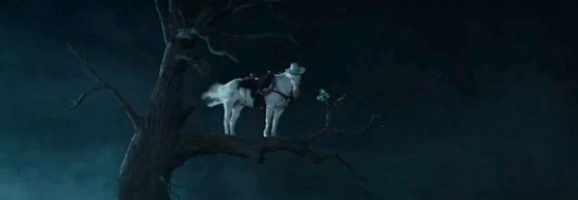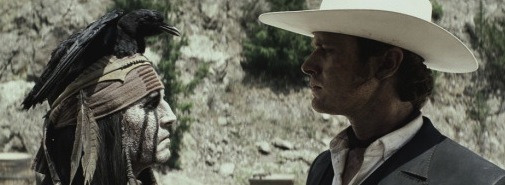The Lone Ranger: An Exercise in Excess

In the tradition of monumental western box-office failures, The Lone Ranger is an exercise in excess. The film ran massively over budget, a characteristic it shares with Michael Cimino’s epic 1980 western Heaven’s Gate, which almost bankrupted its studio, and is widely believed to be one of the biggest box-office bombs of all time. Some have speculated that The Lone Ranger may rival Heaven’s Gate in this regard. But The Lone Ranger’s exorbitance extends further than finances, to its ambitious attempt to simultaneously appeal to disparate audiences and its everything-but-the-kitchen-sink approach to genre.
The Lone Ranger feels anachronous; not just by virtue of its 19th century setting or the questionable depiction of minority groups. It feels anachronous because it’s noticeably trying to appeal to everyone. This ethos results in an identity crisis. Produced by Disney and with its classic western story, the film is designed to appeal to children, with lots of physical comedy and a wacky horse that thinks he’s people. But it also delves into concepts that would be better suited to more nuanced, adult westerns that permit violence and adult themes. However, the coveted US PG-13 rating prevents these concepts from being fully examined; broaching them, then leaving them in favour of more bits with the funny horse.
Two sequences in particular could benefit from a resolution of this tension. The first sees the villainous Butch Cavendish apparently eat the heart of the Lone Ranger’s brother, Dan. I say ‘apparently’ because it’s a little murky. We see Butch place a knife to Dan’s lower abdomen, followed by a series of (filmic) cuts: to Cavendish’s face as he drives the knife home, to one of Butch’s cronies, to another, vomiting, and finally to the Lone Ranger witnessing whatever Butch is doing, the scene reduced to abstract shapes and vague motions reflected in the Lone Ranger’s eye. It’s only later by way of dialogue that we’re properly informed of what’s happened.
I’m not necessarily advocating a re-creation of the whole “Kali Ma! Here’s your still beating heart!” episode in Temple of Doom that scared the bejesus out of so many 80’s children (actually, yes I am – this scene should be recreated whenever possible), but clarity would have added to the emotional gravity of this scene. It’s difficult to feel things if you’re not sure what’s happening. I’m also not entirely convinced that heart eating has a place in children’s movies.
The second sequence depicts Comanche warriors ambushing a rogue band of US Cavalry, led by the greedy and murderous Captain Fuller. A whole community are mown down with Gatling guns. This is followed by a scene that mirrors Tonto’s earlier origin story; in which Tonto, on the bank of a river reflects on the slaughter of a community. This moment of contemplation is very brief – the next scene sees Tonto and the Lone Ranger delighting in equine escapades: now the horse is in a tree, wearing a hat. What is he doing in the tree and why is he even wearing a hat? Silly horse! If this was an adult western, the visceral ugliness of the massacre could be explored in greater detail and afforded due gravity. Instead, these events are trivialised to maintain that PG-13 rating and keep younger audience members on board.

This trivialisation also occurs, in part, because of an excess of content – it tries to cram every kind of western trope into one film (cowboys, Indians, outlaws, drunks, lawyers, law keepers, prostitutes, pioneer women, nature, civilisation, indigenous, introduced, industrialists, townsfolk, all of the horses, monument valley, and so forth), and in doing so fails to fully flesh-out any single element.
This is particularly evident in relation to the portrayal of minority groups. Though the film worked closely with the Comanche nation, native actors are relegated to minor, formulaic roles with limited lines. They appear briefly dancing around a fire, in a tipi and then during battle. The relationship between Native Americans and Europeans is broached literally through the massacre scene, and figuratively in the (introduced) rabbits/“nature is out of balance” motif, but is left half-sketched and easily missed. These moments feel tokenistic, the action swiftly moving past them.
The two female characters receive a similar treatment. Rebecca, the widow of the Lone Ranger’s brother, and love interest of the Lone Ranger (and seemingly every one else) is painfully ineffective. Despite running a homestead in her late husband’s frequent absences, she’s depicted as entirely incapable of completing any physical task. Instead, Rebecca is kidnapped and dragged around, occasionally mustering a futile act of defiance such as spitting in someone’s face or almost hitting someone a bit. This complete passivity coupled with a lack of redeeming qualities (or any other discernable qualities at all) makes it difficult to see why the characters are so enamoured – Rebecca is not a woman; she’s a bundle of attributes devised to motivate other characters. The local brothel madam Red Harrington is more developed than Rebecca, but once again she’s more of a signifier than a person. Red’s more self-possessed than Rebecca, but most of her scenes revolve around her leveraging the fetishizing of her ivory leg-slash-gun. Also, she’s a prostitute – which would be fine if the only other female character wasn’t so insipid.

The Lone Ranger is trying to be everything to everyone. But in trying to appeal to both children and the lucrative 18-35 demographic, neither audience may be entirely satisfied. By bringing up every western trope no single facet can be satisfyingly fleshed-out.
Though not as bad a film as its (emphatically negative) hype suggests, The Lone Ranger’s box office failure will inevitably lead studios to conclude that western genre films are incapable of making money – the same conclusion they drew after Heaven’s Gate flopped in the 80’s. But the problems with these films are not inherent to westerns; their failures are connected with structural issues within the texts themselves. In any case, even though The Lone Ranger probably isn’t the death knell of the western genre, don’t expect to see studios falling over themselves to make westerns anytime soon.
What do you think? Leave a comment.











My granddaughter wanted to go to the movies. Despicable 2 was sold out so we went to watch the Lone Ranger, who always was a favorite of mine. What a waste of money. It had none of the charisma that the original series had. Those who like it probably never grew up with the Lone Ranger.
It was one of the worst Westerns I ever watched. I made a mistake in not reading the reviews before I went but that is what you get when you go on the spur of the moment. This movie deserves a razz berry.
I think you’re right. The film didn’t manage to leverage facets of the original series, which has possibly alienated those who know and love the original text. Despite the world changing considerably since the original was produced, I think it would be possible to produce a modern film with a similar spirit.
You really have to wonder whether Sony is going to survive after their summer money pits. This is, without question, what Spielberg meant when he noted a recently that a couple of mega-flick flops are going to cause a melt-down in Hollywood.
The whole reliance on a handful of blockbusters to maintain profitability seems really counterproductive. Intuitively, the older system of managing financial risk by sharing it across a larger number of medium and small budget films should be the ticket. In this great interview with David Petrarca, director of Boardwalk Empire, Game of Thrones, Big Love, Hung and True Blood (link to interview below) he says he actually pitched this, and was told that the studios need the blockbusters to “feed the machine”; meaning they need films that can move merchandise and become theme park rides. Blerg.
Here’s the link to that interview: http://www.abc.net.au/tv/bigideas/stories/2013/03/25/3719960.htm
I have still yet to see this film. At first it was because I couldn’t find the time, but now I am worried about all the negativity coming out about it. I think the hard aspects with Westerns is that sometimes they can’t be taken seriously, but they try very hard to be. Stereotyping the races and sexes is what went on back then…but that’s very hard to manage these days while still trying to make an enjoyable film. I will still see it…but I will have my reservations.
It seemed like a doomed project from the very beginning. First off, you can’t give us a lone ranger movie and expect your target demographic to have any idea who he is or what he represents (same goes for Tonto in more ways than one). Second, everyone is aware of Johnny Depp’s star power. Marketing a film on his crazy antics is getting old. Not to mention, he is annoyingly overshadowing every lead/titular character (why he doesn’t just play the lead in something I don;t know!). Thirdly, audiences want both grand spectacle and smart storytelling. These two things are what bring people back to the cinema two or three times. This was a stupid project right up there with John Carter and Prince of Persia. Disney needs to find new and exciting ways of targeting younger viewers without needing The Avengers to do it.
I was going to comment with basically everything you said here, but you did the job for me. I agree completely. The first time I saw a trailer for this movie, I knew it would be terrible and would likely bomb. Depp’s act is getting old, and this just looked a big, dumb summer movie.
Frankly I expected it be like Cowboys & Aliens but this movie was even worse than that. THAT says a lot.
That doesn’t say anything.